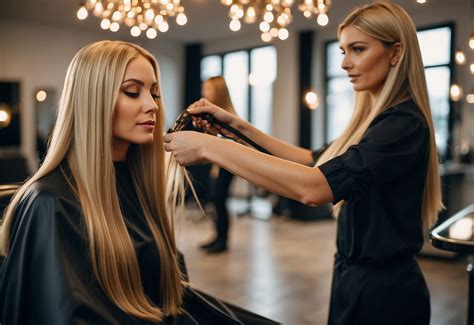Extensions have become increasingly popular as they offer a convenient and versatile way to achieve longer, fuller, or more voluminous hair. However, selecting the right adhesive is crucial to ensure a secure and natural-looking bond between your natural hair and the extensions. This comprehensive guide will explore the different types of glue for extensions, their advantages and disadvantages, and provide tips for choosing the most suitable option for your individual needs.

Understanding the Different Types of Glue for Extensions
Keratin Glue
Keratin glue is the most commonly used adhesive for extensions. It is a protein-based glue that bonds to the natural hair shaft, creating a strong and durable hold. Keratin glue is heat-activated, requiring a heated bonding tool to melt and apply it to the hair.
Advantages:
- Strong and long-lasting bond
- Creates a seamless and natural-looking connection
- Compatible with most hair types
Disadvantages:
- Requires professional application
- Can be time-consuming to install and remove
- Heat can damage natural hair if not applied correctly
Tape-In Glue
Tape-in glue is a thin, double-sided adhesive that comes pre-attached to the extension wefts. The tape is applied to the natural hair directly, creating a quick and convenient bond.
Advantages:
- Easy to install and remove without the need for heat
- Less damaging to natural hair compared to keratin glue
- Can be reused multiple times
Disadvantages:
- Not as strong or long-lasting as keratin glue
- Can be visible or feel bulky if not applied correctly
- Not suitable for all hair types, particularly fine or thin hair
Liquid Glue
Liquid glue, also known as cyanoacrylate glue, is a fast-acting and strong adhesive that can be used for temporary or semi-permanent extensions. It is applied directly to the base of the extension and pressed into the natural hair.
Advantages:
- Quick and easy to apply
- Provides a secure hold
- Affordable and readily available
Disadvantages:
- Can damage natural hair if not removed properly
- Can cause skin irritation
- Not suitable for long-term use
Choosing the Right Glue for Your Needs
Selecting the appropriate glue for your extensions depends on several factors, including:
- Hair Type: Keratin glue is best suited for thick, healthy hair, while tape-in glue is ideal for finer hair types.
- Desired Bond Time: Keratin glue provides a long-lasting bond, while tape-in glue and liquid glue offer more temporary solutions.
- Budget and Convenience: Keratin glue requires professional installation, while tape-in glue and liquid glue can be applied at home for a more affordable option.
- Personal Preference: Some individuals may prefer the seamless appearance of keratin glue, while others appreciate the ease of application with tape-in glue or liquid glue.
Common Mistakes to Avoid When Using Glue for Extensions
- Using too much glue: Applying excessive glue can weaken the bond and damage natural hair.
- Applying glue directly to the scalp: Avoid contact with the scalp to prevent irritation and hair loss.
- Applying glue in a poorly ventilated area: The fumes from glue can be harmful if inhaled.
- Not following application instructions: Carefully read and follow the manufacturer’s instructions to ensure proper adhesion and avoid damage.
- Attempting to remove extensions yourself: Removing extensions improperly can damage natural hair. Consult a professional for safe removal.
Innovative Applications of Glue for Extensions
Beyond traditional hair extension applications, glue can also be used for innovative hair styling techniques, such as:
- Creating hidden hair pieces: Glue can be used to attach hairpieces to your natural hair for a volumizing effect without the need for visible extensions.
- Securing hair accessories: Glue can be used to fixate hairpins, clips, and other accessories to hair, providing a secure hold for special occasions.
- Bridal and updo styling: Glue can be used to create intricate hair designs for weddings, proms, and other formal events.
Resources for Consumers
Conclusion
Choosing the right glue for hair extensions is essential for achieving a secure and natural-looking bond. By understanding the different types of glue, their advantages and disadvantages, and considering your individual needs, you can make an informed decision that will enhance your hair and boost your confidence.
